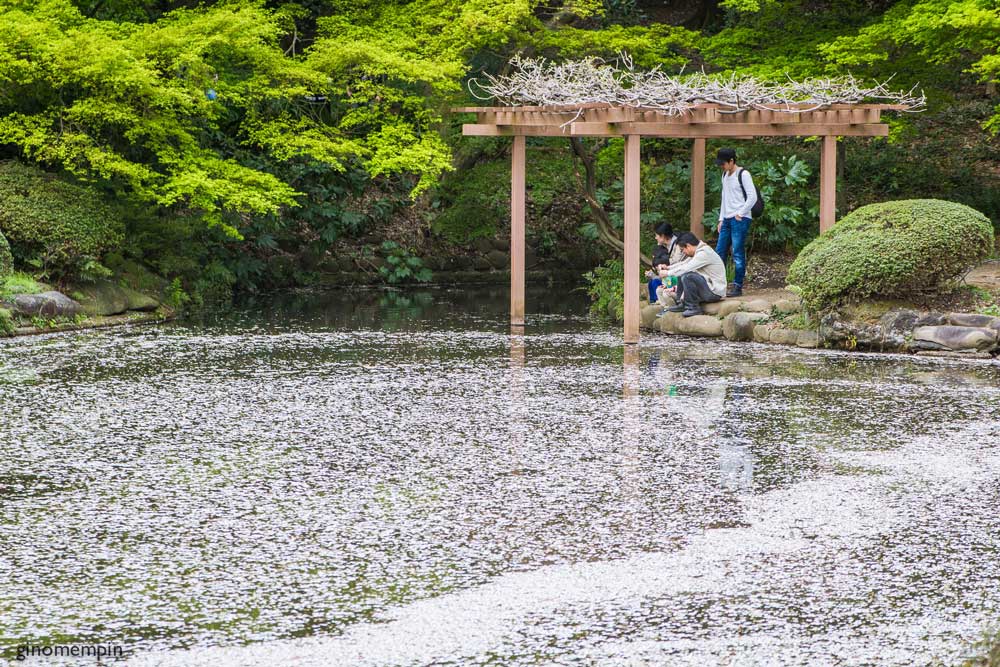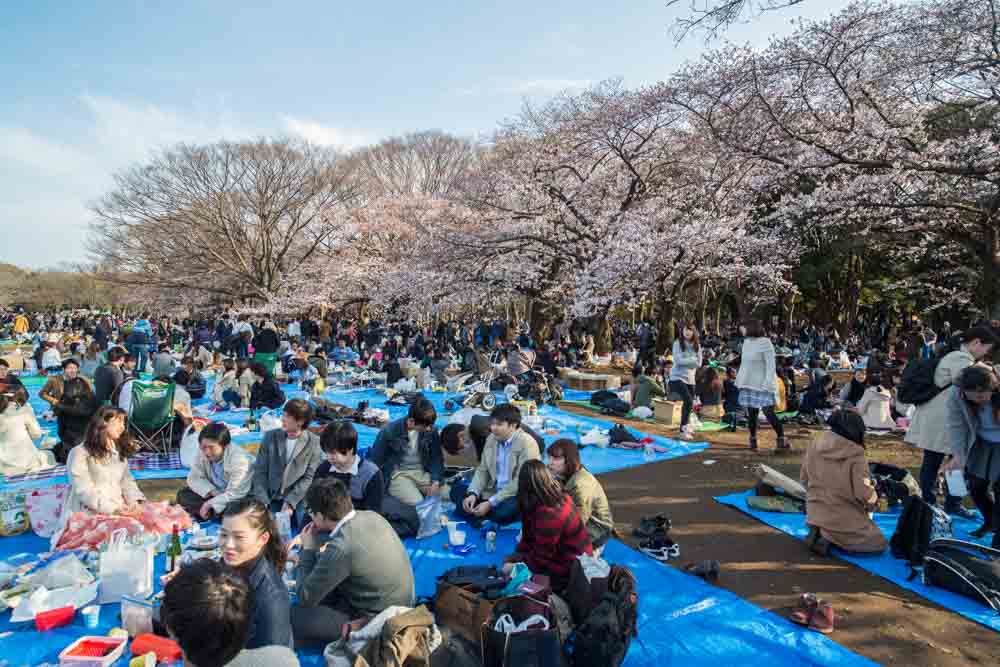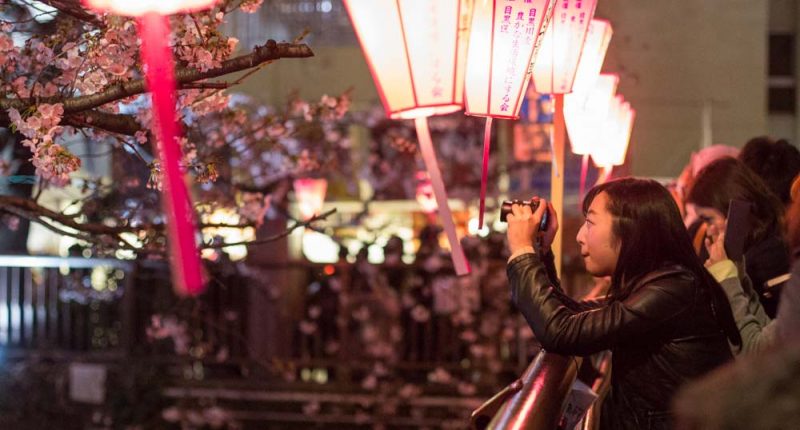The blossoming of the cherry trees begins in Kyushu in mid-March and reaches Tokyo after the 20th of the month. The exact timing can differ by up to one week and while 21/22nd is typical the flowers have not come into bloom until the 30th or 31st in some years. A cherry tree in the grounds of Yasukuni Shrine is used by the Japan Meteorological Agency to officially declare that the flowers are in bloom in Tokyo.
The buds take 7-10 days to reach full bloom (mankai) and the trees remain in bloom for about one week, during which the parks and top cherry blossom spots will fill people taking photographs and picnicking under the trees. So passionate are the Japanese that the pastime of cherry blossom viewing even gets it own word in Japanese: hanami (花見).

In Tokyo there are several recommended sightseeing spots throughout the city, but Yoyogi Park and Ueno Park are especially popular because here visitors are allowed to bring alcohol and picnic under the trees (rules in the landscaped gardens prohibit such activity). There are also a number of places that put on night time illuminations which add a whole new experience to the act of hanami. Of these “Light Ups” the illuminations along Meguro River is one of the most popular, not least because vendors set up stalls along the streets selling pink champagne by the glass and generally creating a superb festive atmosphere.
Shinjuku Gyoen is another spot to bear in mind. Not only are the gardens among the capital’s most beautiful, but they are home to a wider variety of cherry trees than other parks meaning that mankai period is more spread out (good for those who have arrived a little too early or late for the cherry blossoms).
Top Cherry Blossom Spots
Below is a list of the key cherry blossom viewing points, but note that these places—especially the public parks—get extremely crowded during the cherry blossom season and so you are advised to get there early in the morning and/or visit on a weekday.
Shinjuku Gyoen【新宿御苑】

Over 1,000 trees of 65 varieties are to be found in Shinjuku Gyoen. These different varieties all have slightly different blooming times and so the period of full bloom is longer than at other places with some trees blooming well into April.
Nakameguro【中目黒】

Approximately 800 cherry trees line almost 4km of the Meguro River, the branches leaning over the banks and hanging above the water below. This makes for a pleasurable walk during the day, but it is really the night illuminations along the river near Nakameguro Station which attracts the crowds. Vendors line the banks selling pink champagne by the glass and the usual festival foods. See here for more details and photographs.
Shibuya

One of the most easily accessible places in Tokyo to see the cherry blossoms is the aptly named “Sakura Dori” (Cherry Blossom Street). It’s a sloping street lined with bars and eateries just a 3-minute walk from Shibuya Station (take the South Exit of JR Shibuya Station and cross over the main road using the pedestrian bridge above). It’s only about 100 meters long, but cherry blossom trees line the both sides of the narrow street with their branches almost joining over the road (Google Maps link for Sakuragaokacho).
Tokyo Midtown

Tokyo Midtown holds a cherry blossom festival each year with some events indoors and stores selling cherry tree goods. The bridge at the back of the commercial complex provides a great view of the cherry trees along the road, and the Roppongi Terrace restaurant which overlooks it all is a popular draw.
Ueno Park【上野恩賜公園】

Ueno Park has long been a favourite hanami spot in Tokyo. There are about 800 cherry trees in the parks ground many arrive early to get a picnicking spot under the trees. Obviously there are the additional year-round draws of some of Tokyo’s best museums, but unlike Yoyogi Park there are no wide open spaces where you can spread out a ground sheet and relax. Moreover, the metal barricades kind of detract from the scene. See here for more details.
Aoyama Cemetery【青山霊園】

While a cemetery might not seem like the place you want to go to enjoy the cherry blossoms, Aoyama Cemetery is a big draw. The over 300 trees line the road running through the cemetery almost covering the sky overhead.
Yoyogi Park【代々木公園】

Yoyogi Park is one of the most popular spots for hanami due to its vast open spaces and the fact that you are allowed to bring alcohol into the park and picnic. You’ll need to get there early to get a good spot under or near the trees, and please be sure leave your spot clean and tidy afterwards.
Rikugien【六義園】

As in autumn, Rikugien illuminates the cherry blossoms and extends the garden’s opening hours from late March until early April. While there are far fewer cherry blossoms that other spots, there is the stunning Shidare-Zakura, the branches of which flow majestically to the ground. See here for more details about the light-up.
Yasukuni Shrine【靖国神社】

While famous for being home to the single tree which the Japan Meteorological Agency use to determine whether the cherry trees are in bloom, Yasukuni Shrine is an excellent place for cherry blossom viewing in its own right. A multitude of stalls selling anything from candy floss to grilled fish set up in the grounds of the shrine and there are plenty of benches on which people can eat and drink (you’ll need to get there early or be hawk-eyed to secure one, though).
Chidorigafuchi【千鳥ヶ淵】

What could be more Japanese than viewing the cherry blossoms next to the Imperial Palace? Chidorigafuchi is one of the most well-known hanami spots and especially popular with couples who rent dinghies to view the blossoms from the water. See here for more details.
Sumida Koen【墨田公園】

Tokugawa Yoshimune is said to have planted the first cherry tree in the park and today there over 1,000 grace the parks east and west of the Sumida River. A great place to get a shot of the cherry blossoms with Tokyo Skytree in the background. See here for more details.



